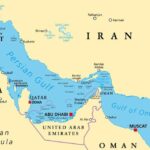Hormuz Strait during the height of the Iranian-Israeli conflict

The Strait of Hormuz, a narrow waterway at the mouth of the Persian Gulf, is currently at the center of global tensions. According to Bloomberg, this is the main shipping route that serves almost 30% of the world’s oil trade.
The escalation of the conflict between Iran and Israel has become a new cause for concern. Iran has repeatedly attacked merchant vessels crossing the strait over the years and has threatened to block transit in the past.
Thus, on April 13, before launching a large-scale attack on Israel using missiles and drones, Iran announced that it had captured an Israeli container ship near the Strait.
Where is the Strait of Hormuz?
The inverted V-shaped waterway connects the Persian Gulf to the Indian Ocean, with Iran to the north and the United Arab Emirates and Oman to the south. It is nearly 100 miles (161 kilometers) long and 21 miles wide at its narrowest point, with waterways in each direction only two miles wide. Its shallow depth makes vessels vulnerable to mines, and its proximity to land (notably Iran) leaves vessels open to attack by shore-based missiles or interception by patrol boats and helicopters.
What is its role?
It is important for world oil trade. Thus, in the first quarter of 2024, tankers transported almost 15.5 million barrels per day of crude oil and condensate from Saudi Arabia, Iraq, Kuwait, the United Arab Emirates and Iran through the strait. The strait is also crucial for liquefied natural gas (LNG), with more than one-fifth of the world’s supply passing through it during the same period — mostly from Qatar.
What exactly is happening?
Iran has for decades used the pursuit of vessels in the Persian Gulf to express its displeasure with sanctions against it or as leverage in disputes. Tehran claimed the latest vessel was detained for violating maritime laws, but analysts pointed to its connection to Israeli property as a motive.
When Iranian forces seized a US-bound tanker in April 2023, Tehran said the ship collided with another vessel. But the move appeared to be in retaliation for US authorities’ seizure of a vessel loaded with Iranian oil off the coast of Malaysia in violation of sanctions.
In May 2022, Iran seized two Greek tankers and held them for six months, allegedly in response to the seizure by Greek and US authorities of Iranian oil on another vessel. Eventually the cargo was released and the Greek tankers released.
Has Iran ever closed the Strait of Hormuz?
Not quite so. During the 1980-1988 war between Iraq and Iran, Iraqi forces attacked an oil export terminal on Kharg Island, northwest of the strait, in part to provoke Iranian retaliation that would draw the United States into the conflict. Subsequently, in the so-called tanker war, both sides attacked 451 vessels. This significantly increased the cost of tanker insurance and contributed to the rise in oil prices.
When sanctions were imposed on Iran in 2011, it threatened to close the strait, but ultimately backed off. Oil traders doubt the country will ever fully close the strait, as it would prevent Iran from exporting its own oil. Also, Iran’s Navy is no match for the US Fifth Fleet and other forces in the region. Commodore Alireza Tansiri, head of the Islamic Revolutionary Guard Corps’ naval forces, said shortly before the latest vessel seizure that Iran had the ability to cut off traffic through the Strait of Hormuz but was reluctant to do so.
Can the channel be protected?
During the tanker war, the US Navy resorted to escorting ships through the Persian Gulf. In 2019, the United States sent an aircraft carrier and B-52 bombers to the region. That same year, the U.S. launched Operation Sentinel in response to Iran’s suspension of shipping. Ten other countries, including the United Kingdom, Saudi Arabia, the United Arab Emirates and Bahrain, later joined the operation, now known as the International Maritime Safety Framework.
From the end of 2023, the main focus on the protection of shipping has shifted from the Strait of Hormuz to the southern part of the Red Sea and the Bab el Mandeb Strait, which connects it to the Gulf of Aden and the Indian Ocean. Attacks by Houthi fighters in Yemen on ships entering or leaving the Red Sea are more worrying than the Strait of Hormuz. A US-led force in the Red Sea is trying to protect shipping in the area.
Who relies on the channel the most?
Saudi Arabia exports most of its oil through the Strait of Hormuz, although it can divert flows with a 746-mile pipeline through the kingdom to a terminal in the Red Sea. The UAE can partially bypass the strait by sending 1.5 million barrels a day by pipeline from its oil fields to the port of Fujairah in the Gulf of Oman. Some of Iraq’s oil is shipped by sea from the Turkish port of Ceyhan, but 85% goes through the strait, making it highly dependent on free passage. Kuwait, Qatar and Bahrain have no other option but to transport their oil by water.





